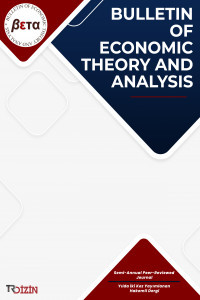Genç Nüfusta İşsizlik Histerisinin Sınanması: Türkiye Örneği
Genç İşsizlik Oranı, Histeri, Doğal Oran Hipotezi
Test ing the Hysteresis in Youth Unemployment: The Case of Turkey
Youth Unemployment Rate, Hysteresis, Natural Rate Hypothesis,
___
- Akcan, A. T. (2019). Türkiye'de gençlerin işsizlik histerisi. Kastamonu Üniversitesi İktisadi ve İdari Bilimler Fakültesi Dergisi, 21(1), 31-47.
- Barışık, S., & Çevik, E. İ. (2008). Yapısal kırılma testleri ile Türkiye’de işsizlik histerisinin analizi: 1923-2006 dönemi. Karamanoğlu Mehmetbey Üniversitesi İktisadi ve İdari Bilimler Fakültesi Dergisi, (14), 109-134.
- Blanchard, O. J., & Summers, L. H. (1986). Hysteresis and the European unemployment problem. NBER macroeconomics annual, 1, 15-78.
- Campbell, J. Y., & Mankiw, N. G. (1987). Are output fluctuations transitory?. The Quarterly Journal of Economics, 102(4), 857-880.
- Çınar, M., Akay, H., & Yılmaz, F. (2014). A sectoral analysis of hysteresis in unemployment: Evidence from Turkey. Bilig (69), 29-52.
- Çemrek, F., & Şeker, T. (2020). Türkiye’de kadın işsizlik oranlarının yapısal kırılmalı birim kök testleri ile incelenmesi. Ankara Hacı Bayram Veli Üniversitesi İktisadi ve İdari Bilimler Fakültesi Dergisi, 117-132.
- Dickey, D. A., & Fuller, W. A. (1979). Distribution of the estimators for autoregressive time series with a unit root. Journal of the American statistical association, 74(366a), 427-431.
- Dickey, D. A., & Fuller, W. A. (1981). Likelihood ratio statistics for autoregressive time series with a unit root. Econometrica: journal of the Econometric Society, 1057-1072.
- Enders, W., & Lee, J. (2012). The flexible Fourier form and Dickey–Fuller type unit root tests. Economics Letters, 117(1), 196-199.
- Friedman, M. (1995). The role of monetary policy. In Essential Readings in Economics (pp. 215-231). Palgrave, London.
- Kahyaoğlu, H., Tuzun, O., Ceylan, F., & Ekinci, R. (2016). İşsizlik Histerisinin Geçerliliği: Türkiye ve Seçilmiş AB Ülkeleri Üzerine Bir Uygulama. Manisa Celal Bayar Üniversitesi Sosyal Bilimler Dergisi, 14(4), 103-128.
- Narayan, P. K., & Popp, S. (2010). A new unit root test with two structural breaks in level and slope at unknown time. Journal of Applied Statistics, 37(9), 1425-1438.
- Narayan, P. K., & Popp, S. (2013). Size and power properties of structural break unit root tests. Applied Economics, 45(6), 721-728.
- Nelson, C. R., & Plosser, C. R. (1982). Trends and random walks in macroeconmic time series: some evidence and implications. Journal of monetary economics, 10(2), 139-162.
- Ozturk, M. (2020). Türkiye’de İşsizlik Histerisi Hipotezinin Geçerliliği: Çok Boyutlu ve Asimetrik Yaklaşım. OPUS Uluslararası Toplum Araştırmaları Dergisi, 15(1), 4882-4910.
- Phelps, E. S. (1968). Money-wage dynamics and labor-market equilibrium. Journal of political economy, 76(4, Part 2), 678-711.
- Phelps, E. S. (1994). Structural slumps: The modern equilibrium theory of unemployment, interest, and assets. Harvard University Press.
- Saraç, T. B. (2014). Hysteresis effect in unemployment: Turkey case. Ege Akademik Bakış Dergisi, 14(3), 335-344.
- Tekin, İ. (2018). Türkiye'de işsizlik histerisi: Fourier fonksiyonlu durağanlık sınamaları. Dokuz Eylül Üniversitesi İktisadi İdari Bilimler Fakültesi Dergisi, 33(1), 97-127.
- Topalhan, T., Durusoy, Ö. T., & Özdemir, Z. A. (2017). İşsizlik oranı üzerindeki şoklar gerçekten kalıcı mı: Türkiye ekonomisi üzerine bir analiz. SGD-Sosyal Güvenlik Dergisi, 7(2), 87-104.
- Türkiye İstatistik Kurumu (TÜİK). İstihdam, işsizlik ve ücret istatistikleri. (Erişim Tarihi: 10.12.2020)
- Yılancı, V. (2011). Yapısal Kırılmalar Altında Türkiye İçin İşsizlik Histerisinin Sınanması. Doğuş Üniversitesi Dergisi, 10(2), 324-335.
- Yıldırım, S. (2011). Türkiye’de histeri hipotezinin geçerliliğinin çoklu yapısal kırılmalı CKP birim kök testiyle sınanması. Akdeniz İİBF Dergisi, 11(22), 28-47.
- Sigeze, Ç., Coşkun, N., & Ballı, E. (2019). AB ülkelerinde ve Türkiye'de işsizlik histerisinin Fourier-KPSS birim kök testi ile incelenmesi. İzmir İktisat Dergisi, 34(1), 15-24.
- Zivot, E., & Andrews, D. W. K. (2002). Further evidence on the great crash, the oil-price shock, and the unit-root hypothesis. Journal of business & economic statistics, 20(1), 25-44.
- Yayın Aralığı: Yılda 2 Sayı
- Başlangıç: 2016
- Yayıncı: Mehmet SONGUR
Genç Nüfusta İşsizlik Histerisinin Sınanması: Türkiye Örneği
The Affect of Behavioral Risk Factors on Healthcare System Performance
Mehmet Emin KURT, Cuma ÇAKMAK, Murat KONCA, İsmail BİÇER
MINT Ülkelerinde Ara Girdi ve Nihai Talebin İthalat Bağımlılığı: Girdi-Çıktı Analizi
